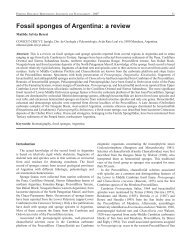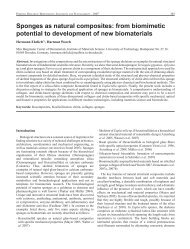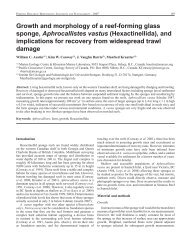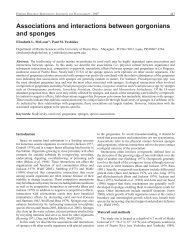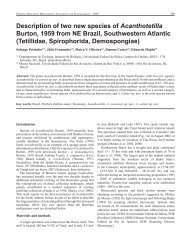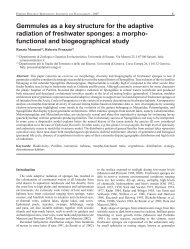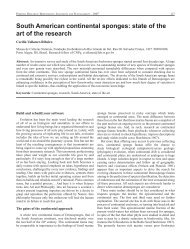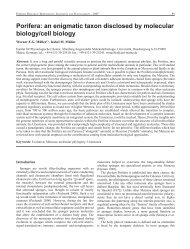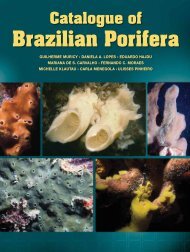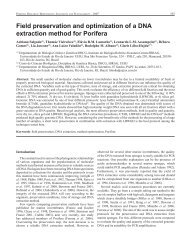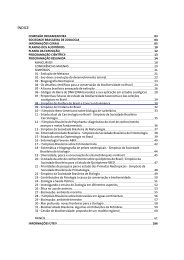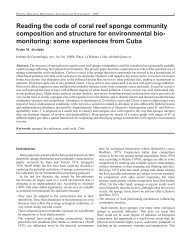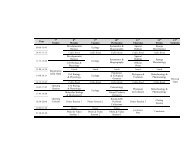- Page 2 and 3: Universidade Federal do Rio de Jane
- Page 4: Borojevic, Roberto Berlinck and Sol
- Page 10 and 11: viHeinz C. Schröder, Anatoli Krask
- Page 13 and 14: Porifera Research: Biodiversity, In
- Page 15: Fig. 1: Relative abundances ofpoten
- Page 18 and 19: Fig. 4: Example of meta-analysis as
- Page 20 and 21: 10Pronzato R, Bavestrello G, Mancon
- Page 22 and 23: 12Juan (Beresi and Banchig 1997). A
- Page 24 and 25: 14Precordillera (Cuyania) Terrane,
- Page 26 and 27: 16The greatest generic and specific
- Page 28 and 29: 18Fig. 4: Ordovician spongespicules
- Page 31: 21Beresi MS, Esteban SB (2003) Spon
- Page 34 and 35: 24Fig. 1: A. Polymastia harmelinisp
- Page 36 and 37: 26Fig. 4: Polymastia harmelini sp.
- Page 38 and 39: 28Fig. 7: Polymastia harmelini sp.n
- Page 40 and 41: 30no description in the paper and i
- Page 42 and 43: 32Table 1: Sponge species with cyan
- Page 44: 34Table 1 (cont.)Aplysinidae 10 Apl
- Page 49: ReferencesCox GC, Hiller RG, Larkum
- Page 52 and 53: 42Fig. 1: Ernst Haeckel (1834-1919)
- Page 54 and 55: 44Fig. 4: Yves Delage (1854-1920) a
- Page 56 and 57: 46Fig. 7: The trend in sponge embry
- Page 58 and 59: 48Fig. 10: The basal-apical andpost
- Page 60 and 61: 50For example, parenchymella may or
- Page 62 and 63: 52Mukhina YI, Kumeiko VV, Podgornay
- Page 64 and 65: 54Propagated contractions in sponge
- Page 66 and 67: 56TissuesUnder the hypothesis of sp
- Page 68 and 69: 58Boury-Esnault N, Ereskovsky A, Be
- Page 71 and 72: Porifera Research: Biodiversity, In
- Page 74 and 75: 64Table 1 (cont.)Heteromeyenia Pott
- Page 76 and 77: 66Table 1 (cont.)Pachydictyum Weltn
- Page 78 and 79: 68Fig. 2: Schematic reconstructiono
- Page 80 and 81: 70Fig. 5: Gemmular structurein diff
- Page 82 and 83: 72pneumatic layer is absent (Figs 6
- Page 84 and 85: 74Fig. 9: Corvospongillamesopotamic
- Page 86 and 87: 76Harrison FW, Gleason PJ, Stone PA
- Page 89 and 90: Porifera Research: Biodiversity, In
- Page 91 and 92: 81Fig. 1: The fist panel shows EM,
- Page 93 and 94: 83Fig. 3: Schematic presentation of
- Page 95 and 96:
85pair could hold the weight of 160
- Page 97 and 98:
References87Fig. 7: Electrophoretic
- Page 99 and 100:
Porifera Research: Biodiversity, In
- Page 101 and 102:
localized on the cell periphery. Th
- Page 103 and 104:
93Fig. 3: Phylogenetic position of
- Page 105 and 106:
Also the iron concentration, as Fe
- Page 107 and 108:
97major enzyme involved in the deto
- Page 109 and 110:
99identified in S. domuncula whose
- Page 111 and 112:
101Fig. 7: A. Wnt signaling pathway
- Page 113 and 114:
103Fig. 8: Schematic view of patter
- Page 116 and 117:
106Rasmont R (1979) Les éponge: de
- Page 118 and 119:
108Biodiversity of carnivorous spon
- Page 120 and 121:
110Table 1: Characters of the gener
- Page 122 and 123:
112All the presumed carnivorous spo
- Page 124 and 125:
114with Esperiopsidae and of Euchel
- Page 127 and 128:
Porifera Research: Biodiversity, In
- Page 129 and 130:
119(Berroa Belén 1968). The South
- Page 131:
121Tavares MCM, Volkmer-Ribeiro C,
- Page 134 and 135:
124The pitfalls and conceptual weak
- Page 136 and 137:
126Fig. 2: The structure of the Spo
- Page 138 and 139:
128revision. The database currently
- Page 141 and 142:
Porifera Research: Biodiversity, In
- Page 143 and 144:
ResultsSponges comprised more than
- Page 145 and 146:
135Fig. 3: Linear regression betwee
- Page 147:
137Gasparini JL, Floeter S R (2001)
- Page 150 and 151:
140Initially five sponges were sele
- Page 152 and 153:
142Fig. 3: Growth rate of A. vastus
- Page 154 and 155:
144Fig. 6: Living A. vastus sponge
- Page 157 and 158:
Porifera Research: Biodiversity, In
- Page 159 and 160:
149Fig. 1: Sampling localities(lett
- Page 161 and 162:
151Fig. 3: A. Chalinula nematifera
- Page 163 and 164:
153et al. 2006). However, we do not
- Page 165 and 166:
ReferencesAerts LAM (1998) Sponge/c
- Page 168 and 169:
158the Università Politecnica dell
- Page 170 and 171:
160data but based on field observat
- Page 172 and 173:
162BiogeographyTwenty-three species
- Page 174 and 175:
164Pile AJ, Grant A, Hinde R, Borow
- Page 176 and 177:
166nitrifying microorganisms. First
- Page 178 and 179:
168weight day -1 (Fig. 3C) respecti
- Page 180 and 181:
170Fig. 5: Schematic diagram showin
- Page 183:
Porifera Research: Biodiversity, In
- Page 186 and 187:
176Table 1A-C: Three compound group
- Page 188 and 189:
178Curvularia lunata and Cladospori
- Page 190 and 191:
180group of sponges as documented t
- Page 192 and 193:
182Fig. 2: Phylogenetic relationshi
- Page 194 and 195:
184Fig. 4: Spicules and axial filam
- Page 196 and 197:
186Fig. 6: A. Comparison of the int
- Page 198 and 199:
188demosponges (example Suberites d
- Page 200 and 201:
190Class Demospongiae Sollas, 1885O
- Page 202 and 203:
192Fig. 3: A. Specimen ofPseudosube
- Page 204 and 205:
194Fig. 5: A. Stelodoryx argentinae
- Page 206 and 207:
196Fig. 7: A. Fragments of Tedania(
- Page 208 and 209:
198Fig. 9: A. Tedania armata.Sarà,
- Page 210 and 211:
200Fig. 11: A. Specimen of Guitarra
- Page 213 and 214:
Porifera Research: Biodiversity, In
- Page 215 and 216:
205Fig. 2: Dissolution rates ofClio
- Page 217 and 218:
207Fig. 5: Macroscopic boring patte
- Page 219 and 220:
209
- Page 221 and 222:
Porifera Research: Biodiversity, In
- Page 223 and 224:
Fig. 2: Schematic representation of
- Page 225 and 226:
215Fig. 7: Sperman Rank correlation
- Page 227:
217Jackson J, Winston JE (1982) Eco
- Page 230 and 231:
220Spicules: Megascleres: styles I:
- Page 232 and 233:
222Fig. 3: Artemisina apollinis(Rid
- Page 234 and 235:
224Fig. 5: Mycale (Oxymycale)acerat
- Page 236 and 237:
226Fig. 7: Haliclona (Gellius) rudi
- Page 238 and 239:
228Fig. 9: Haliclonissa verrucosaBu
- Page 240 and 241:
230Fig. 11: Microxina phakelloides(
- Page 242 and 243:
232Sollas WJ (1888) Report on the T
- Page 244 and 245:
234Fig. 1: Map showing the location
- Page 246 and 247:
236Table 1: Occurrence and semi-qua
- Page 249 and 250:
Porifera Research: Biodiversity, In
- Page 251 and 252:
Fig. 1: Examples from soft-bottoms
- Page 253 and 254:
243
- Page 255 and 256:
245and coarse sediments. Fine sedim
- Page 257 and 258:
Porifera Research: Biodiversity, In
- Page 259 and 260:
249Fig. 2: Underwater photographs o
- Page 261 and 262:
251death. In relatively narrow band
- Page 263 and 264:
253de Laubenfels 1950 (see Rützler
- Page 265 and 266:
Porifera Research: Biodiversity, In
- Page 267 and 268:
Table 1: Survey sampling effort and
- Page 269 and 270:
259Fig. 2: A. Mean (+ 1 SE) density
- Page 271 and 272:
261Fig. 3: Relationships between me
- Page 273:
263Lidz BH, Reich CD, Peterson RL,
- Page 276 and 277:
266Fig. 1: Cored primary fibres and
- Page 278 and 279:
268Fig. 9: Cored primary fibre fasc
- Page 280 and 281:
270Fig. 16: Heavily armoured dermis
- Page 282 and 283:
2727. Fenestrate or ridged surface;
- Page 284 and 285:
274Schmitt et al. (2005), based on
- Page 286 and 287:
276Fig. 1: Map of Todos os SantosBa
- Page 288 and 289:
27812.7-31.8-53.8 (SD=11.2) (N=30)
- Page 290 and 291:
280Forschungsreise nach Westindien.
- Page 292 and 293:
282this definition gastrulation wou
- Page 294 and 295:
284that delamination in hexactinell
- Page 296 and 297:
286Even a simple cover layer of cel
- Page 298 and 299:
288endoderm by an extracellular mat
- Page 300 and 301:
290The Drosophila 93DE homeobox gen
- Page 302 and 303:
292Bekkum DWV (2004) Phylogenetic a
- Page 304 and 305:
294a developmental gene in the lowe
- Page 307 and 308:
Porifera Research: Biodiversity, In
- Page 309 and 310:
299farming treatments for Coscinode
- Page 311 and 312:
301Fig. 5: Final survival and growt
- Page 313 and 314:
Porifera Research: Biodiversity, In
- Page 315 and 316:
X-ray analysisX-ray diffraction mea
- Page 317 and 318:
307Fig. 2: SEM images: A. E. asperg
- Page 319 and 320:
309Fig. 4: A. TEM micrograph of dem
- Page 321 and 322:
311Fig. 6: Schematic view:biomimeti
- Page 323 and 324:
Porifera Research: Biodiversity, In
- Page 325 and 326:
eader (Multimode Detector DTX 880,
- Page 327 and 328:
317enough, normal cells were not af
- Page 329 and 330:
Porifera Research: Biodiversity, In
- Page 331 and 332:
Table 1: Sites in the coastal Georg
- Page 333 and 334:
Table 2: List of sponge species obs
- Page 335:
ReferencesAlcolado PM (1990) Genera
- Page 338 and 339:
328Fig. 1: Map of the study area. F
- Page 340 and 341:
330Fig. 4: Reproductive elementsof
- Page 342 and 343:
332to be gonochoristic (Witte and B
- Page 345 and 346:
Porifera Research: Biodiversity, In
- Page 347 and 348:
337on 13 July 2006 for analyses of
- Page 349 and 350:
339Fig. 2: Non-metric multi-dimensi
- Page 351 and 352:
341tolerant of high turbidity than
- Page 353:
343Monteiro LC, Muricy G (2004) Pat
- Page 356 and 357:
346Fig. 1: Schematic diagram of the
- Page 358 and 359:
348only say that it varies. In the
- Page 360 and 361:
350Fig. 5: Diagram of the basal app
- Page 363 and 364:
Porifera Research: Biodiversity, In
- Page 365 and 366:
355Table 1 (cont.)56 Halicometes mi
- Page 367 and 368:
357Family Tedaniidae Ridley and Den
- Page 369:
359Lerner C, Hajdu E (2002) Two new
- Page 372 and 373:
362RNA genes are preferably used fo
- Page 374 and 375:
364Fig. 2: Map showing the localiti
- Page 376 and 377:
366
- Page 378 and 379:
368Table 3: Amino acid exchanges (u
- Page 380 and 381:
370AcknowledgementsWe would like to
- Page 383 and 384:
Porifera Research: Biodiversity, In
- Page 385 and 386:
375Fig. 1: Cytochrome oxidase subun
- Page 387:
377des Übereinkommens über die bi
- Page 390 and 391:
380Fig. 2: Sampling site in the Fra
- Page 392 and 393:
382Max Planck Society. F.H. and O.S
- Page 394 and 395:
384and Palaeospongillidae (fossil f
- Page 396 and 397:
386Table 1: List of species followi
- Page 398 and 399:
388Fig. 1: Neighbour-joining phylog
- Page 400 and 401:
390is also the only species within
- Page 403 and 404:
Porifera Research: Biodiversity, In
- Page 405 and 406:
395Fig. 1: New Zealand and the sout
- Page 407 and 408:
397Table 2: Checklist and geographi
- Page 409 and 410:
DiscussionLithistid demosponges are
- Page 411 and 412:
401Fig. 3: Modern-day circulationpa
- Page 413 and 414:
403Pub Carnegie Inst 467, Papers fr
- Page 415 and 416:
Porifera Research: Biodiversity, In
- Page 417 and 418:
407clones. The insert size ranged f
- Page 419 and 420:
409Table 1 (cont.)89-4 2.8 1234 mit
- Page 421 and 422:
411could be evolutionarily closer t
- Page 423 and 424:
Porifera Research: Biodiversity, In
- Page 425 and 426:
415Fig. 2: Reproduction effort of P
- Page 427 and 428:
417Fig. 6: Reproductive period ofdi
- Page 429 and 430:
Porifera Research: Biodiversity, In
- Page 431 and 432:
421Mutation Detection System was us
- Page 433 and 434:
423
- Page 435:
425Olson JB, McCarthy PJ (2005) Ass
- Page 438 and 439:
428commercially important molluscs
- Page 440 and 441:
430Fig. 3: Histogram representing t
- Page 442 and 443:
432trials in association with two u
- Page 444 and 445:
434ethanol were used as developers.
- Page 446 and 447:
436Table 1: In vitro cytotoxicity a
- Page 449 and 450:
Porifera Research: Biodiversity, In
- Page 451 and 452:
441Table 1: Species of Foraminifera
- Page 453 and 454:
Porifera Research: Biodiversity, In
- Page 455 and 456:
Table 2: Associations of sponges an
- Page 457 and 458:
447Fig. 3: Overgrowth of a Gorgonia
- Page 459 and 460:
Porifera Research: Biodiversity, In
- Page 461 and 462:
451of Isla Margarita), 3422-3464 m.
- Page 463 and 464:
453Fig. 3: Spicules of the holotype
- Page 465 and 466:
455Fig. 4: Spicules of Lophocalyxbi
- Page 467 and 468:
457The largest pentactines located
- Page 469 and 470:
459Table 5: Some measures of spicul
- Page 471 and 472:
Fig. 9: Lophocalyx reiswigi sp. nov
- Page 473 and 474:
463Table 8: Some measures of spicul
- Page 475:
465is a monotypic genus known from
- Page 478 and 479:
468we agree with van Soest and Sten
- Page 480 and 481:
470
- Page 482 and 483:
472Table 1: Spicular characteristic
- Page 484 and 485:
4743B. Dichotriaenes with long rhab
- Page 487 and 488:
Porifera Research: Biodiversity, In
- Page 489 and 490:
479
- Page 491 and 492:
481Fig. 5: Streptasters. A. SEM mic
- Page 493 and 494:
Porifera Research: Biodiversity, In
- Page 495 and 496:
485of flagellated cells (AB S, fina
- Page 497 and 498:
487
- Page 499 and 500:
oth internal and surface cells in j
- Page 501 and 502:
Porifera Research: Biodiversity, In
- Page 503 and 504:
493Table 1: Presence of haloperoxid
- Page 505 and 506:
495Fig. 4: UV-visible spectrum of t
- Page 507 and 508:
Porifera Research: Biodiversity, In
- Page 509 and 510:
499outer appearance; all explants o
- Page 511 and 512:
501Table 1: Concentrations of iron
- Page 513 and 514:
Porifera Research: Biodiversity, In
- Page 515 and 516:
505depth 8.5 m) and have complex, l
- Page 517 and 518:
507Fig. 9: Mean elongation after 24
- Page 519 and 520:
Porifera Research: Biodiversity, In
- Page 521 and 522:
511Fig. 3: Acanthotetilla rocasensi
- Page 523 and 524:
513Fig. 5: Acanthotetilla walteri s
- Page 525:
515two southwestern Atlantic specie
- Page 528 and 529:
518sections on slides. For surface
- Page 530 and 531:
520Styles intermediate in size also
- Page 532 and 533:
522722 x 778 μm, and lie loosely i
- Page 535 and 536:
Porifera Research: Biodiversity, In
- Page 537 and 538:
527Table 1: List of Antarctic stati
- Page 539 and 540:
529Fig. 3: Myxilla (Myxilla) elonga
- Page 541 and 542:
531Fig. 5: Myxilla (Burtonanchora)a
- Page 543 and 544:
533Fig. 7: Myxilla (Burtonanchora)m
- Page 545 and 546:
535Fig. 8: Myxilla (Burtonanchora)m
- Page 547 and 548:
537Fig. 10: Myxilla (Burtonanchora)
- Page 549 and 550:
539Fig. 12: Myxilla (Burtonanchora)
- Page 551 and 552:
541Fig. 14: Myxilla (Burtonanchora)
- Page 553 and 554:
543Fig. 16: Myxilla (Ectyomyxilla)h
- Page 555 and 556:
545Figure 18: Map of localities and
- Page 557 and 558:
Porifera Research: Biodiversity, In
- Page 559 and 560:
549Fig. 1: Area studied by the Proj
- Page 561 and 562:
551Fig. 3: Skeletal characters ofCi
- Page 563:
553Muricy G, Hajdu E (2006) Porifer
- Page 566 and 567:
556Material and methodsCollection,
- Page 568 and 569:
558Fig. 4: DNA quality statedetermi
- Page 570 and 571:
560Janeiro (FAPERJ) and Conselho Na
- Page 572 and 573:
562in embryos and larvae of several
- Page 574 and 575:
564Fig. 1: Transmission electron mi
- Page 576 and 577:
566Fig. 3: A. 16S rDNA-DGGE gelof I
- Page 578 and 579:
568Maldonado M, Cortadellas N, Tril
- Page 580 and 581:
570sponge communities on severely h
- Page 582 and 583:
572Fig. 2: Sample location CoralGar
- Page 584 and 585:
574Table 1: Summary of results on d
- Page 586 and 587:
576Fig. 4: Minimum light-adapted or
- Page 588 and 589:
578Fig. 6: Relative chlorophyll aco
- Page 590 and 591:
580Schönberg CHL, Loh WK (2005) Mo
- Page 592 and 593:
582Fig. 1: A. Spicules, oxeae and t
- Page 594 and 595:
584Fig. 5: 3-Dimensional modeling o
- Page 596 and 597:
586Fig. 10: Galectin-2. The two S.
- Page 598 and 599:
588Fig. 13: Formation of spicules i
- Page 600 and 601:
590Fig. 15: Sponge spicules as opti
- Page 602 and 603:
592Molecular cloning of silicatein
- Page 604 and 605:
594poriferans recorded for Brazil,
- Page 606 and 607:
596Table 1: Comparative data on spi
- Page 608 and 609:
598Fig. 3: Skeletal arrangement of
- Page 610 and 611:
600Fig. 5: Microscleres of Geodia g
- Page 612 and 613:
602Silva CM, Mothes B, Lyrio-Olivei
- Page 614 and 615:
604description and discovery. But f
- Page 616 and 617:
606units (ESUs) sampled (through th
- Page 618 and 619:
608Fig. 1: The “Spiculometer”.
- Page 620 and 621:
610The “gold nugget” of DNA bar
- Page 622 and 623:
612Thalmann O, Hebler J, Poinar HN,
- Page 624 and 625:
614Material and methodsThe sampling
- Page 626 and 627:
616Fig. 3: Spermatogenesis in Geodi
- Page 628 and 629:
618
- Page 630 and 631:
620sponges releases their eggs and
- Page 632 and 633:
622symbionts, molecular phylogeneti
- Page 634 and 635:
624species and symbiont type (unice
- Page 636 and 637:
626ReferencesCheshire AC, Wilkinson
- Page 638 and 639:
628in polar regions (Wright et al.
- Page 640 and 641:
630Similar synergistic effects have
- Page 642 and 643:
632show considerable quantitative a
- Page 644 and 645:
634innate immune reactions in spong
- Page 646 and 647:
636Müller WEG, Müller IM (2003) O
- Page 649 and 650:
Porifera Research: Biodiversity, In
- Page 651 and 652:
641Fig. 2: Number of spicules forme
- Page 653:
643Braekman JC (eds). Sponges in ti
- Page 656 and 657:
646Position and depth of all collec
- Page 658 and 659:
648observed in a ‘Hopper Camera
- Page 660 and 661:
650Fig. 3: Rossella nodastrellaTops
- Page 662 and 663:
652Schulze FE (1887) Report on the
- Page 664 and 665:
654Table 1: Chemical differences am
- Page 666 and 667:
656Fig. 2: Agarose gel electrophore
- Page 668 and 669:
658analyses have some advantages ov
- Page 671 and 672:
661Authors IndexAAlbano, Rodolpho M
- Page 673:
663Rutten, Leanne M................
- Page 676 and 677:
666Aplysina fistularis 4, 34, 314-3
- Page 678 and 679:
668Cladorhiza thomsoni 522Cladorhiz
- Page 680 and 681:
670Ephydatia fortis 63Ephydatia jap
- Page 682 and 683:
672Heterorotula contraversa 64Heter
- Page 684 and 685:
674Mycale fibrexilis 321, 323, 324,
- Page 686 and 687:
676Polluted sites 03-05, 341Polluti
- Page 688 and 689:
678Spongia irregularis 159, 160, 16
- Page 690 and 691:
680
- Page 692 and 693:
682Participants ListAAdams, Charles
- Page 694:
684RRaleigh, Jean (206)Rangel, Mari



